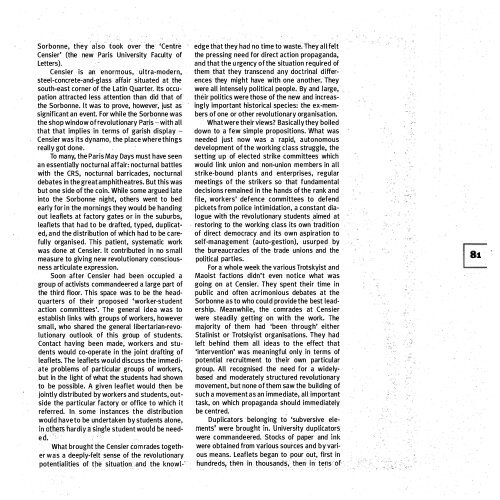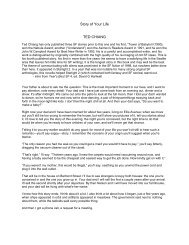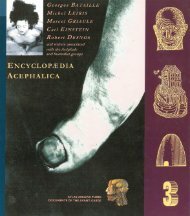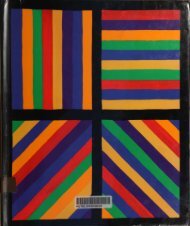SITUATIONISTS AND THE 1£CH MAY 1968
umMYFs
umMYFs
You also want an ePaper? Increase the reach of your titles
YUMPU automatically turns print PDFs into web optimized ePapers that Google loves.
- -<br />
Sorbonne, they ' also took over the 'Centre<br />
Censier' (the new Paris University Faculty of<br />
Letters).<br />
Censier is an enormous, ultra-modern,<br />
steel-concrete-and-glass affair situated at the<br />
south-east corner of the Latin Quarter. Its occupation<br />
attracted less attention than did that of<br />
the Sorbonne. lt was to prove, however, just as<br />
significant an event. For while the Sorbonne was<br />
the shop window ofrevolutionary Paris .:., with all<br />
that that implies in terms of garish display<br />
Censier was its dynamo, the place where things<br />
really got done.<br />
To many, the Paris May Days must have seen<br />
an essentially nocturnal affair: nocturnal battles<br />
with the CRS, nocturnal barricades, nocturnal<br />
debates in the great amphitheatres. But this was<br />
but one side of the coin. While some argued late<br />
into the Sorbonne night, others went to bed<br />
early for in the mornings they would be handing<br />
out leaflets at factory gates or in the suburbs,<br />
leaflets that had to be drafted, typed, duplicated,<br />
and the distribution of which had to be care·<br />
fully organised. This patient, systematic work<br />
was done at Censier. lt contributed in no small<br />
measure to giving new revolutionary consciousness<br />
articulate expression.<br />
Soon after Censier had been occupied a<br />
group of activists commandeered a large part of<br />
the third floor. This space was to be the headquarters<br />
of their proposed 'worker-student<br />
action committees'. The general idea was to<br />
establish links with groups of workers, however<br />
small, who shared the general libertarian-revolutionary<br />
outlook of this group .of students.<br />
Contact having been made, workers and students<br />
would co-operate in the joint drafting of<br />
leaflets. The leaflets would discuss the immediate<br />
problems of particular groups of workers,<br />
but in the light of What the students had shown<br />
to be possible. A given leaflet would then be<br />
jointly distributed by workers and students, out·<br />
side the particular factory or office to which it<br />
referred. In some instances the distribution<br />
would have to be undertaken by students alone,<br />
in others hardly a single student would be needed.<br />
What brought the Censier comrades together<br />
was a deeply-felt sense of the revolutionary<br />
potentialities of the situation. and the know!-<br />
edge that they had no time to waste. They allfelt<br />
the pressing need for direct action propaganda,<br />
and that the urgency of the situation required of<br />
them that they transcend any doctrinal differences<br />
they might have with one another. They<br />
were all intensely political people. By and large,<br />
their politics were those of the new and increasingly<br />
important historical species: the ex-members<br />
of one or other revolutionary organisation.<br />
What were their views? Basically they boiled<br />
down to a few simple propositions. What was<br />
needed just now was a rapid, autonomous<br />
development of the working class struggle, the<br />
setting up of elected strike committees which<br />
would link union and non-union members in all<br />
strike-bound plants and enterprises, regular<br />
meetings of the strikers so that fundamental<br />
decisions remained in the hands of the rank and<br />
file, workers' defence committees to defend<br />
pickets from police intimidation, a constant diac<br />
logue with the revolutionary students aimed at<br />
restoring to the working class its own · tradition<br />
of direct democracy and its own aspiration to<br />
self-management (auto-gestion), usurped by<br />
the bureaucracies of the trade unions and the<br />
political parties.<br />
For a whole week the various Trotskyist and<br />
Maoist factions didn't even notice what was<br />
going on at Censier. They spent their time in<br />
public and often acrimonious debates at the<br />
Sorbonne as to who could provide the best leadership.<br />
Meanwhile, the comrades at Censier<br />
were steadily getting on with the work. The<br />
majority of them had 'been through' either<br />
Stalinist or Trotsl










